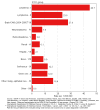Children's exposure to diagnostic medical radiation and cancer risk: epidemiologic and dosimetric considerations
- PMID: 19083224
- PMCID: PMC2814780
- DOI: 10.1007/s00247-008-1026-3
Children's exposure to diagnostic medical radiation and cancer risk: epidemiologic and dosimetric considerations
Abstract
While the etiology of most childhood cancers is largely unknown, epidemiologic studies have consistently found an association between exposure to medical radiation during pregnancy and risk of childhood cancer in offspring. The relation between early life diagnostic radiation exposure and occurrence of pediatric cancer risks is less clear. This review summarizes current and historical estimated doses for common diagnostic radiologic procedures as well as the epidemiologic literature on the role of maternal prenatal, children's postnatal and parental preconception diagnostic radiologic procedures on subsequent risk of childhood malignancies. Risk estimates are presented according to factors such as the year of birth of the child, trimester and medical indication for the procedure, and the number of films taken. The paper also discusses limitations of the methods employed in epidemiologic studies to assess pediatric cancer risks, the effects on clinical practice of the results reported from the epidemiologic studies, and clinical and public health policy implications of the findings. Gaps in understanding and additional research needs are identified. Important research priorities include nationwide surveys to estimate fetal and childhood radiation doses from common diagnostic procedures, and epidemiologic studies to quantify pediatric and lifetime cancer risks from prenatal and early childhood exposures to diagnostic radiography, CT, and fluoroscopically guided procedures.
Figures
References
-
- Ries LAG, Melbert D, Krapcho M, et al., editors. SEER Cancer Statistics Review, 1975–2005. National Cancer Institute; Bethesda, MD: 2008. based on November 2007 SEER data submission, posted to the SEER web site( http://seer.cancer.gov/csr/1975_2005/), 2008.
-
- Steliarova-Foucher E, Stiller C, Lacour B, et al. International Classification of Childhood Cancer, third edition. Cancer. 2005;103:1457–1467. - PubMed
-
- Ross JA, Spector LG. Cancers in Children. In: Schottenfeld D, Fraumeni JF Jr, editors. Cancer Epidemiology and Prevention. 3. Oxford University Press; Bethesda, Maryland: 2006. pp. 1251–1261.
-
- Parkin DM, Kramarova E, Draper GJ, et al. IARC Scientific Publications No. 144: International Incidence of Childhood Cancer. II. International Agency for Research on Cancer (IARC); Lyon, France: 1998.
-
- Ries LAG, Smith MA, Gurney JG, et al. Cancer incidence and survival among children and adolecents: United States SEER program 1975–1995. National Cancer Institute, SEER program, NIH; Bethesda, Maryland: 1999. Pub. No. 99-4649.
Publication types
MeSH terms
Grants and funding
LinkOut - more resources
Full Text Sources
Medical



